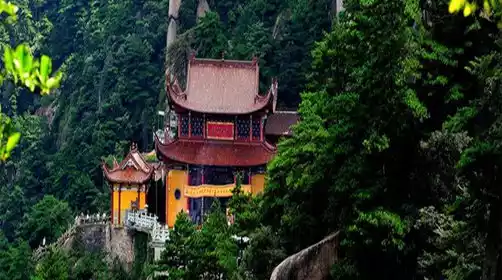Day 1 Nanjing → Jiuhua Mountain
07:00
From 07:00 to 07:15, we gathered and signed in at Exit 1 of Andemen Station on Nanjing Metro Line 1, where we saw the yellow China-TravelNote flag.
07:15
Set off on time and laugh all the way.
11:15
After a short break, we started our journey on the front mountain blessing loop of Jiuhua Mountain.
First stop: Huacheng Temple, the founding temple of Jiuhua Mountain. Historical records indicate that an Indian monk named Beidu came here to practice Buddhism in 401 AD, marking the introduction of Buddhism to Jiuhua Mountain. Then, you'll hike to Ksitigarbha Temple, Yueshen Hall, and Shangchan Hall. This area is a major Buddhist temple complex on Jiuhua Mountain. After Ksitigarbha Bodhisattva's nirvana 1,200 years ago, his body remained intact, his features resembling a lifelike state. His disciples later placed his remains here. You'll also visit Dongya Temple, offering panoramic views of Tiantai Peak and Jiuhua Street. From here, you can descend the mountain to your hotel. Those with more energy can continue their journey to the Sleeping Buddha Observation Deck and the Baisui Palace.
5:00 PM
We will have dinner at our own pace on Jiuhua Street and stay at Jiuhua Tianjie at night.


Day 2 Jiuhua Mountain → Taohuatan
07:30
After breakfast, we started our journey across the back mountain of Jiuhua Mountain (Tiantai-Huatai crossing). This journey has magnificent scenery along the way, and it is famous for its strange peaks and rocks, and magnificent sea of clouds.
Take the local scenic shuttle to the Phoenix Pine, a tree over 1,400 years old. From there, ascend the mountain (you can also take the cable car to the Ancient Sutra Platform at your own expense), passing Huiju Temple to the summit of the Ancient Golden Platform and the Yixiantian (One-Line Sky) peak. From here, gaze out over the peaks of Jiuhua Mountain, including the towering Ten Kings Peak (1,342 meters). Then, follow the mountain ridgeline to visit the temples of Tiantai Temple, Luohandun Temple, Lotus Platform Peak, and Small Flower Platform, before reaching the summit of Flower Platform for a panoramic view of Jiuhua.
2:00 PM
We took the Huatai Cableway down the mountain (at our own expense)
3:30 PM
The bus waited for a long time at the foot of the mountain, then we took the bus.
5:00 PM
Arrive at the hotel near Taohuatan, have dinner at your own leisure and have a good rest after dinner.


Day 3 Taohuatan → Zhaji → Nanjing
08:00
Don't be lazy this morning, because the morning mist at Taohuatan is famously dreamy. (This natural wonder is a result of its location downstream of the Taiping Lake Reservoir. The river water flowing from the reservoir dam maintains a constant temperature of around 14-17°C year-round. Four kilometers downstream from the dam, the river surface at Taohuatan is colder in the mornings and evenings, creating a significant temperature difference with the air. This condenses into water vapor, forming mist.) This is exactly what the poet Li Bai envisioned when he saw this peach blossom wonderland. Don't miss out!
09:00
After breakfast, we strolled through the ancient town, quietly absorbing this pure land. As we reached the river, I couldn't help but recall the poem "To Wang Lun," which goes, "The waters of Taohuatan are a thousand feet deep, yet they cannot compare to the love Wang Lun bestowed upon me." Here, you'll find well-preserved, millennia-old cultural relics. You can climb a pavilion overlooking the ancient town and explore the tomb of the heroic figure Wang Lun.
10:30
We set off for the Chazhi Ancient Village, where "Chazhi Village is a village of ten miles, nine miles of smoke, and three streams surround thousands of households. Under the shadow of temples, pavilions, and towers, small bridges flow by the water and apricot blossoms bloom."
Chazhi Ancient Village is a village of the Cha family in Jiangnan. It has a long history and beautiful scenery. It is a low-key ancient village with not many tourists coming here, but the scenery is very beautiful. The ancient village retains ancient buildings from the Yuan, Ming and Qing dynasties. The "Degong Hall" built in the Yuan Dynasty is one of the main attractions.
The ancient village is surrounded by mountains, with Cenxi, Xuxi, and Shixi rivers running through it. Built along the river, the banks and alleys are paved with stone slabs. The roads follow the water, winding and twisting for miles.
12:00
Happy dinner in the ancient town on a AA basis.
2:00 PM
Then we returned by car.
6:00 PM
When we returned to our starting point in Nanjing, everyone was reluctant to leave and kissed goodbye with tears in their eyes!







